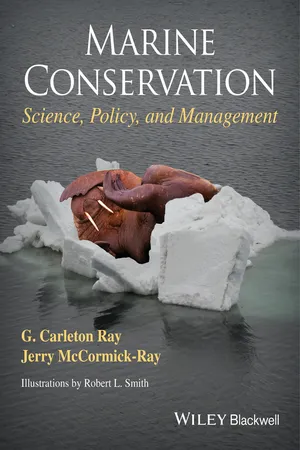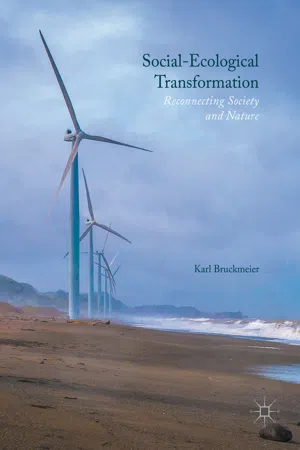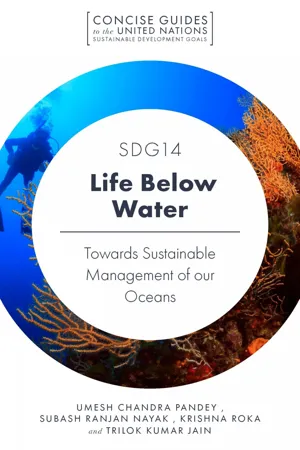Coastal Management
Coastal management refers to the strategies and actions implemented to protect and sustainably utilize coastal areas. It involves measures such as beach nourishment, seawalls, and dune restoration to mitigate erosion and flooding, as well as zoning regulations to control development. The goal is to balance human activities with the preservation of coastal ecosystems and natural processes.
5 Key excerpts on "Coastal Management"
- eBook - ePub
Marine Conservation
Science, Policy, and Management
- G. Carleton Ray, Jerry McCormick-Ray, Robert L. Smith(Authors)
- 2013(Publication Date)
- Wiley-Blackwell(Publisher)
...Lack of a national political-will to coordinate and protect nature and sustainably manage development, particularly in coastal-marine environments, creates unanticipated discordance in meeting socio-political priorities. South Africa is blessed with 3000 km of highly diverse and productive coastal systems. Its oceanographic configuration and climate determine the productivity of terrestrial and marine ecosystems and the all-important land-sea interactions between them. Effective Coastal Management must therefore be based on recognition of natural processes and their protection. Sadly, this has not yet been recognized adequately in South Africa. For example, sugar cane farming on riverine floodplains is creating extreme habitat degradation. Estuaries are being degraded, despite their essential role as feeding and nursery areas for commercially valued species, so critical to local communities. Furthermore, the apparent inability or unwillingness of governmental authorities to plan for sustainable resource use, to regulate and enforce line fishing, or to curb blatant and large-scale poaching of abalone, will predictably contribute to ecological collapse. Of equal importance, especially with respect to the biosphere-reserve concept, is effective planning of development in which equal access is given to all members of society. This KBR case study broadly outlines efforts being carried out through private-sector collaboration with government to overcome these problems. The development of an Integrated Coastal Management Plan, which enjoyed wide acceptance during the course of public participation, has yet to be implemented due to lack of political and financial support and lack of coordination among government departments at national to local levels that share common goals...
- eBook - ePub
Social-Ecological Transformation
Reconnecting Society and Nature
- Karl Bruckmeier(Author)
- 2016(Publication Date)
- Palgrave Macmillan(Publisher)
...With the new initiative of marine spatial planning no significant change and renewal happens, more a broadening of conventional management and planning practices from the land to the sea. The Common Fisheries Policy of the EU achieved little success in converting top-down governance and implementing fisheries co-management in efforts to control overfishing. After more than twenty years of experimenting with cooperation and participation (McCay and Jentoft 1996 ; Symes 2006 ; Coers et al. 2012), the further development of co-management is unclear, rather expected through influence of the ideas of adaptive governance and sustainable resource management (Linke and Bruckmeier 2015). Participatory management in marine protected areas is studied in few case studies only (for example Vasconcelos et al. 2013); the debate about different understandings of the purposes of protection continues (see below). Adaptive management in coastal fisheries has, in Europe and elsewhere, brought few successful examples (Walters 2007). In coastal areas, adaptive management could be adopted for the management of water- and land-based resources. But the experience with its introduction showed that it did not spread rapidly and easily, also not with newer improvements (see Chap. 6). Coastal conflict management is badly supported from governmental institutions and shows big deficits, as well as in the framework of ICZM, as in other approaches (Bruckmeier 2014 ; Stepanova 2015). The spreading of newer approaches, for example, conflict mediation, is a slow and difficult process, the necessity of conflict mitigation itself disputed in coastal research. Ecosystem-based management in coastal areas and in fisheries management, intensively discussed in the USA, is not widespread in Europe. The majority of European fisheries is still based on single-species assessment and ignores, according to Mollmann et al. (2013), the wider ecosystem context...
- eBook - ePub
- John Roff, John Roff(Authors)
- 2013(Publication Date)
- Routledge(Publisher)
...Unfortunately management in the coastal zone is complicated by overlapping or competing political and governance jurisdictions, lack of knowledge of environmental conditions and even lack of definition of what the coastal zone really comprises (Mercer Clarke et al, 2008). There are many ways to define and describe the coastal zone and its biological communities. However, for conservation planning, the coastal zone can be considered to encompass: seaward – the fringing communities to the depth of the euphotic zone; and landward to the extent of the sea – either physically as encountered by land, or chemically as limited by the null zone in estuaries. Conservation planning in the coastal zone has not received adequate attention due partly to the high level of complexity and lack of analysis of data required for the appropriate mapping of geophysical factors. The intention in this chapter was to show how the coastal zone and its component inlets can be quantitatively described and analyzed, largely from existing or readily obtainable data, as a basis for decision-making for conservation and other management purposes. In the nearshore, coastal inlets define naturally repeating geomorphic units at a scale above that of habitats, which can be classified using an ecosystem-based conservation approach (Green-law, Roff and Redden, unpublished). A three-level classification is suggested that recognizes and quantifies both marine and freshwater influences on the coastal zone and its inherent physical and ecological complexity...
- eBook - ePub
Sustainable Coastal Management and Climate Adaptation
Global Lessons from Regional Approaches in Australia
- Richard Kenchington, Laura Stocker, David Wood(Authors)
- 2012(Publication Date)
- CSIRO PUBLISHING(Publisher)
...The socioeconomic and biophysical consequences of failure to address the issues are increasingly apparent. National and international technical and legal instruments provide the basis for addressing the issues, but challenges of creating and implementing functional arrangements for management, particularly at the local scale, are great. In most cases these require multiple jurisdictions and agencies with different cultures and operating conditions to cooperate to address complex problems where causes and effects, and costs and benefits can be widely separated in space, time, culture and jurisdiction. ENDNOTE 1 < http://web.worldbank.org/external/projects/main?pagePK=64312881&piPK=64302848&theSitePK=40941&Projectid=P097985 >. REFERENCES Aalbersberg, B, Tawake, A and Parras, T (2005) Village by village: recovering Fiji’s coastal fisheries. In: World Resources 2005: The Wealth of the Poor: Managing Ecosystems to Fight Poverty, pp. 144–152. World Resources Institute, Washington DC. Andalecio, M (2011.) Including coastal resource users in fisheries management evaluation of San Miguel Bay, Philippines. Ocean and Coastal Management 54 (10): 760–770. Aswani, S, Christie, P, Muthiga, NA, Mahon, R, Primavera, JH, Cramer, LA, Barbier, EB, Granek, EF, Kennedy, CJ, Wolanski, E and Hacker, S (2012) The way forward with ecosystem-based management in tropical contexts:Reconciling with existing management systems. Marine Policy 36 : 1–10. Cao, W and Wong, MH (2007.) Current status of coastal zone issues and management in China: A review. Environment International 33 : 985–992. CEC (Commission of the European Communities) (2000a) Communication from the Commission to the Council and the European Parliament on Integrated Coastal Zone Management: A Strategy for Europe: COM/2000/0547 Final. CEC, Brussels. CEC (2000b) Directive 2000/60/EC: Water Framework Directive. CEC, Brussels. CEC (2007) Communication from the Commission: An Integrated Maritime Policy for the EU: COM (2007)574 Final...
- eBook - ePub
SDG14 - Life Below Water
Towards Sustainable Management of our Oceans
- Umesh Chandra Pandey, Ranjan Nayak, Krishna Roka, Trilok Kumar Jain(Authors)
- 2021(Publication Date)
- Emerald Publishing Limited(Publisher)
...Around this time the tourism industry had started becoming a major source of foreign exchange. Coastal erosion began to be perceived as threat to the economic, physical and social life of coastal inhabitants of the islands, and the media drew attention to this issue. The need for safeguarding beach tourism on the island therefore became an economic necessity. It led to the concept of coastal zone management in Barbados (Coastal Zone Management, n.d,). Against this background, the Barbadian government secured financial assistance from the Inter-American Development Bank (IDB) to carry out the island’s first coastal conservation study for the west and south coasts in 1981. Several reasons were identified for coastal erosion, and a draft Coastal Management plan for the south and west coasts was developed. The Government of Barbados is currently implementing the Coastal Risk Assessment and Management Program, entirely financed by the IDB, aimed at improving the conservation and management of the coastal zone (Coastal Risk Management Programe, n.d.). The government, with its Coastal Risk Management Programme performs Coastal Risk Assessments, develops resilient and sustainable coastal infrastructure and builds strong institutional capacity for integrated coastal zone management (Coastal Zone Management, n.d.). In this context, the Coastal Zone Management Unit of Barbados has tried to address beach erosion and flooding caused by unsustainable development activity in the past and recently potential climate change and SLR. A mixture of hard and soft engineering, green architecture and landscaping has been used in some coastal locations of Barbados. For instance, recently built seawalls at Welches in Christ Church and Rockley Beach have a mixture of mini-headlands and groynes. As a result, this has reduced beach erosion and increased beach accretion along certain parts of the coast (Mycoo & Chadwick, 2012)...




